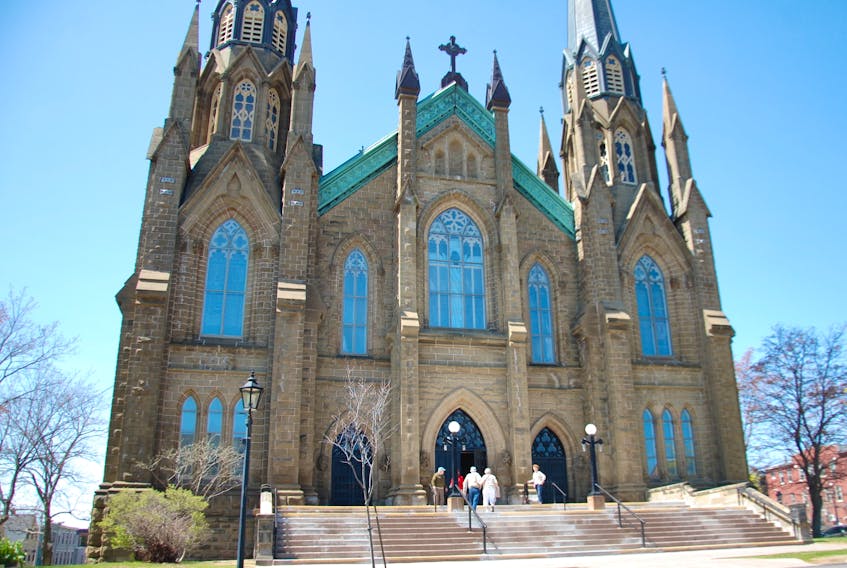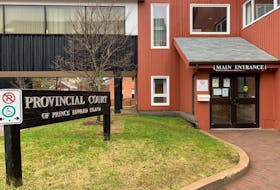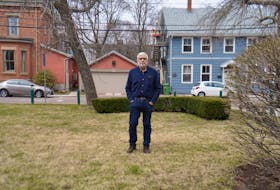CHARLOTTETOWN, P.E.I. — It is Crystal Joseph’s piece of heaven.
The Charlottetown woman is drawn daily to St. Dunstan’s Cathedral Basilica on Great George Street in the capital city.
The strikingly majestic building is her favourite spot.
“I think this church is the most beautiful place I’ve ever been in my life,’’ says Joseph.
“I’ve never been to heaven before, but when I look at that architecture, I feel like I’m there. It’s a very beautiful, breathtaking, spiritual place. I feel like if whenever we do go to heaven, it’s going to resemble a lot of this.’’
For 100 years, people have been coming to worship in this cathedral – the fourth church to sit in the same location on Great George Street, a block away from Province House. Others come just to take in the wonder of the structure.

St. Dunstan snapshot
St. Dunstan was an abbot of Glastonbury Abbey, a bishop of Worcester, a bishop of London, and an archbishop of Canterbury, later canonized as a saint. His work restored monastic life in England and reformed the English Church.
Rev. Keith Kennific, 63, received his first communion and confirmation at St. Dunstan’s in 1963 and 1964 respectively. His family moved out of the parish when he was 13.
He has recently returned to his boyhood church, now as rector of the cathedral parish of the Diocese of Charlottetown – the second oldest English-speaking diocese in Canada after Kingston, Ont.
The church captivates him today, just as it did when he was a child.
“It is awe-inspiring and, actually, the architecture was meant for it to be that way – to draw your attention up,’’ he says.
Kennific estimates the congregation, which basically encompasses the downtown core of Charlottetown, consists of between 600 and 700 households. Services held in the evening on Saturday and in the morning and evening on Sunday draw between 600 and 800 people.
“We have a fairly mixed congregation,’’ he says.
“We do have a fair number of young families…and we have quite a multinational congregation – a lot of new Canadians. It’s a nice mix.’’

Kennific says St. Dunstan’s Cathedral Basilica is not just for the congregation but for everyone, open seven days a week, from 8 a.m. to 5 p.m.
“I think for many people, even if they aren’t churchgoers, to come into a space like that, there’s a sobering element to it in a certain sense,’’ he says.
“There is a certain awe-inspiring reality.’’
Kennific says he has “no idea’’ how many tourists pop in and out of the cathedral in the run of a year.
Roughly 1,600 people signed the registrar over just a two-month period in July and August in 2015. The most common comment penned in the book was simply “beautiful’ with “amazing”, “peaceful”, “magnificent”, “spectacular”, “breathtaking” and “inspirational” also used by visitors.
Those who took time to share their wonderment over the cathedral came from across Canada and around the world with Mexico, Paraguay, Tokyo, the U.K., Italy, Australia and Spain among the tourists’ homelands.
A cruise ship brought more of those world travellers flowing into the building this past Wednesday.
Mary Butteweg, a Catholic churchgoer from Connecticut, sat for a while, lit a candle and walked throughout the cathedral.
“It has this way of being both majestic and calming and understated at the same time,’’ she says.
“I think it’s inviting, actually.’’
When Vic Malkowicz of Michigan, looking out on Charlottetown from the cruise ship HALS Zaandam, saw the cathedral’s twin spires piercing the sky, he thought they were likely perched atop a relatively modest wooden structure.
When he walked up Great George Street with his wife, Sally, he was surprised to see a building that was actually a massive church made of stone.
“It’s very beautiful,’’ he says.
“It’s of the magnitude of Italy, I would think. This is a cathedral you would expect to see in a million to two million population area. Very gorgeous.’’
Since January, the church’s centenary has been celebrated with numerous historical sketches in the church bulletin prepared by Rev. Art O’Shea, the archivist for the Diocese of Charlottetown.
O’Shea has long been in awe of the building, which he refers to as the cathedral rather than the basilica, the latter an honorary title bestowed 90 years ago by the pope at the time.
“For little Charlottetown, Prince Edward Island, this is a most magnificent building built by the common people,’’ he says.
“It’s a place of quiet, which is hard to find today.’’
A centenary concert, held May 25, offered an overview of St. Dunstan’s life as well as a sketch of the cathedral’s 100-year history. A sampling of liturgical music and hymnody from 1919 to the present was also played.
Special touches
St. Dunstan's Cathedral Basilica is an impressive site with plenty to take in. Here are some notable features:
- French gothic exterior design with 10-foot tall spiral crosses at the top of twin spires
- Four carvings at the outside doors depicting gospel writers Matthew, Mark, Luke and John
- Focal point of interior is the 37-foot high altar and 44-foot long altar screen
- The cathedral houses 23 statues of saints and angels. The German-crafted rose window spans 14 feet
- Nearly 300 angel representations are presented in stained glass
In September, a centennial mass and picnic will be held. Kennific adds a couple of further events may take place in the fall.
The rector notes the building is quite a beast to maintain with heating an ongoing economic and environmental challenge.
Repairs have just been made to the expansive stairs leading up to the church, but the need to replace them remains a major, upcoming project.
A large fundraising effort has seen the bells, which were silent for more than three decades, ringing again since Canada Day 2017. Eighteen church bells were re-installed in the north tower of the basilica after a tune-up at the foundry in South Carolina where they were initially produced in the 1920s.
The bells were taken down from the steeple in the late ’70s because of structural concerns.
“Well, you know, there’s something about a church bell, isn’t there, that says a lot of things in its music, in its sound, calling people to an attention of something that’s beyond ourselves,’’ says Kennific.
Joseph does not need the bells to beckon her.
She will often spend an hour in the church but has stayed put six times that long in the peaceful surroundings of the cathedral.
“It’s a place you can go when you are down and out and you’re in the darkness and you might need to see the light,’’ she says.
“It’s the most natural drug in the world.’’
Timeline
St. Dunstan's Cathedral Basilica – the official church of the bishop of the Diocese of Charlottetown – is the fourth church built on the same Great George Street site. Here is how it came to be:
- A primitive wooden church was built on this site in 1816.
- A new larger wooden cathedral replaced the church in 1843.
- The cornerstone of the third of the four cathedrals, and the first one built of stone, was laid in 1896. In 1913, just six years after the cathedral’s dedication, it was destroyed by fire.
- The fourth, and current, cathedral was completed in 1919. It was the largest and most fire-resistant cathedral in the Maritimes. One decade later, to mark the 100th anniversary of the Diocese of Charlottetown, the pope honoured the enormous financial sacrifices Islanders made to resurrect the cathedral from its ashes by granting St. Dunstan’s the title of basilica – one of only 20 in Canada to bear this honorary tag.
- In 1990, the federal government designated St. Dunstan's Cathedral Basilica a National Historic Site of Canada, citing it as one of the most elaborate churches in the Maritimes and a fine example of high Victorian gothic revival architecture.









